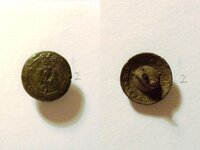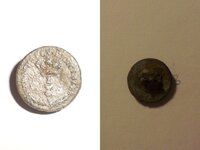ott
Jr. Member
Hi there ,this being my first post hopefully some one will id these buttons as i have no idea ,i have looked through various referance books but am unable to find them .
The pictured (2) has a scottish thistle with crown above and below has the number 9 , i am unable to read the writing around the outer part of the button itself.
The picture (3) again has a thistle and between the thistle and the crown a number 1 . around the outer part of the button i can just make out the wording (i think)
TRATHS ?EY FENCIBLES.
Any help will be much appreciated .
The pictured (2) has a scottish thistle with crown above and below has the number 9 , i am unable to read the writing around the outer part of the button itself.
The picture (3) again has a thistle and between the thistle and the crown a number 1 . around the outer part of the button i can just make out the wording (i think)
TRATHS ?EY FENCIBLES.
Any help will be much appreciated .






